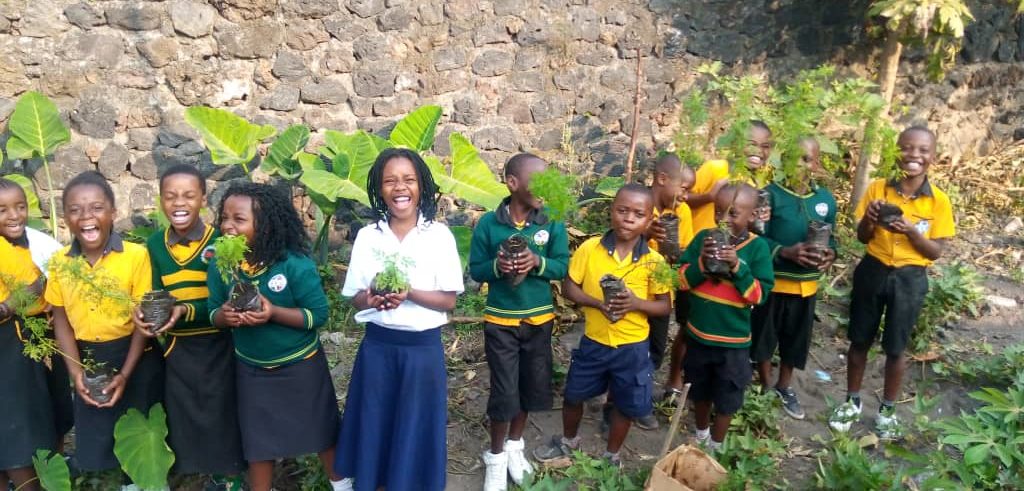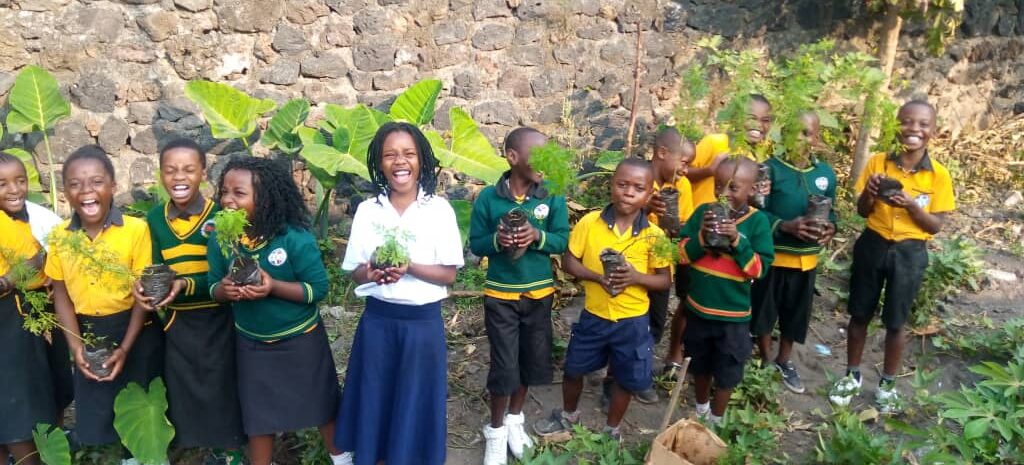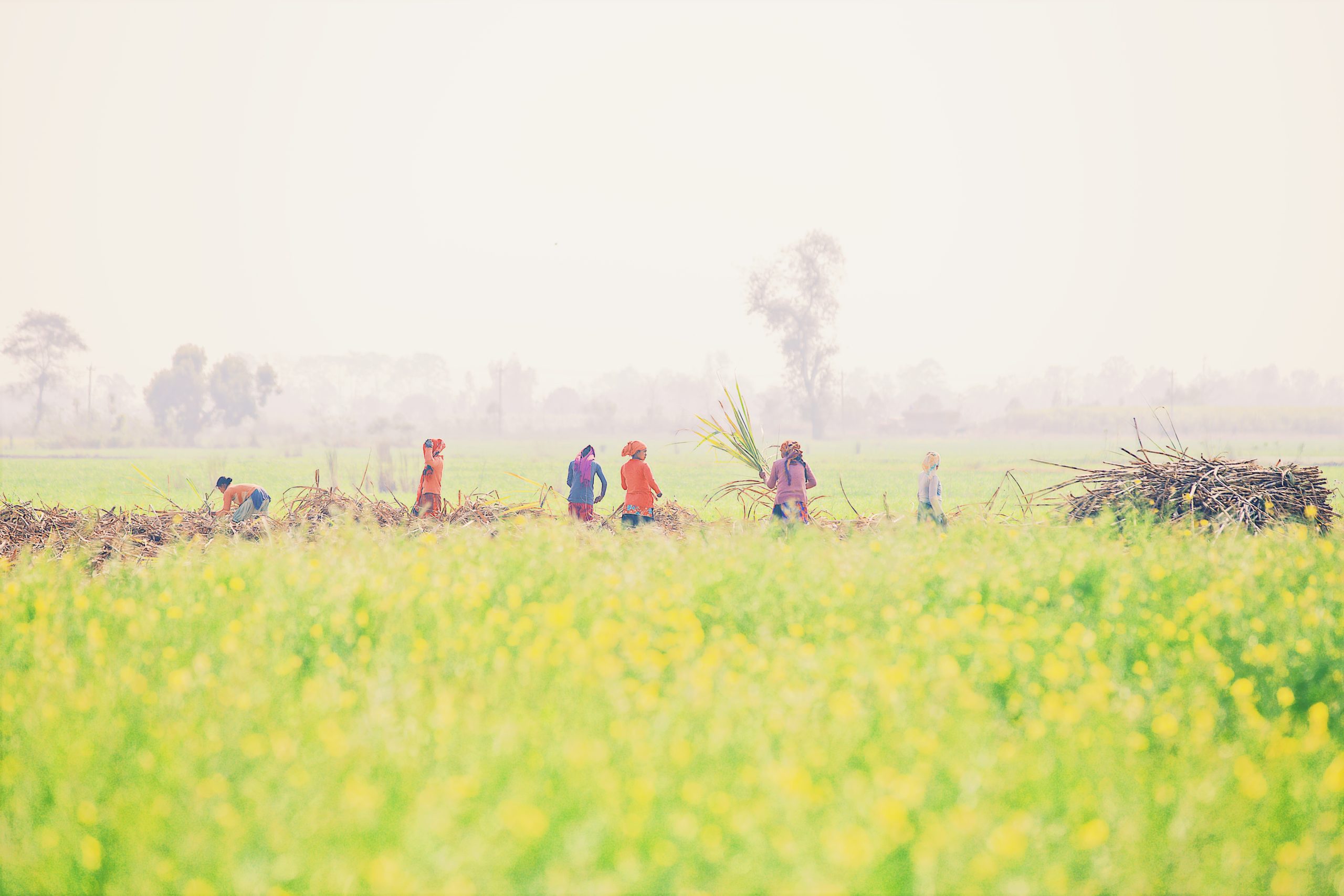In the Lawḥ-i-Dunyá (Tablet of the World), Bahá’u’lláh exhorted humankind to pay special regard to agriculture, emphasizing its vital importance to the advancement of civilization.1Bahá’u’lláh, Tablets of Bahá’u’lláh, 7. Lawḥ-i-Dunyá (Tablet of the World). Available at www.bahai.org/r/512736869 ‘Abdu’l-Bahá further elaborated on this theme in His writings and talks, highlighting the role of the farmer as the “first active agent in human society” and stating that “the question of economics must commence with the farmer and then be extended to the other classes.”2Abdu’l-Bahá, from a Tablet dated 4 October 1912 to an individual believer—translated from the Persian, included in the compilation “Economics, Agriculture and Related Subjects” by the Research Department of the Universal House of Justice, published in Compilation of Compilations, Volume 3, pages 5-17, 2000.“The fundamental basis of the community is agriculture, tillage of the soil,” He shared on another occasion. “All must be producers.”3Abdu’l-Bahá, The Promulgation of Universal Peace, Talks in New York, 1-15 July 1912: 77. 309 West Seventy-eighth Street
Little wonder, then, that Bahá’í communities have, throughout the history of the Faith, paid “special regard to agriculture,” especially in the arena of social action. In Sub-Saharan Africa, where approximately two-thirds of the population is engaged in farming on either a full- or part-time basis,4Available at http://www.fao.org/family-farming/regions/africa/en/ the past decades have provided an especially rich opportunity for learning about the application of these teachings in practice. This article reviews developments in recent decades and surveys selected initiatives across the continent, with particular focus on central Africa.
The Rise of Collective Capacity for Agricultural Development
Agriculture is commonly considered to be the backbone of the African economy, contributing between 30 and 60 percent of gross domestic product for each country.5Available at https://www.britannica.com/place/Africa/Agriculture The majority of this production is carried out on family farms less than one hectare in size; in fact, 95% of the farms in sub-Saharan Africa are smaller than five hectares.6Available at http://www.fao.org/family-farming/regions/africa/en/ For the most part, these farms operate at a subsistence level to feed the family and serve local markets. There are limited or no means to irrigate or to access costly inputs such as improved seed varieties, fertilizers, pesticides, or mechanized equipment. Yet despite a large percentage of the population being engaged with agricultural production activities, food security continues to be a challenge for the continent.7Among the factors threatening food security are population growth and the related issue of land shortage; the impact of climate change on rainfall and temperature patterns; soil infertility, partly caused by popular trends pushing farmers away from their traditionally diverse systems of production as well as the dependency the trends have created for chemical fertilizers that lose their effect over time; difficulties of controlling pests that have become resistant to the inorganic pesticides; the disappearance of local varieties of seeds from communities; the lack of quality in seeds purchased in the market with low germination rates; and conflict and epidemics that hinder populations of affected countries from producing and accessing food.
Bahá’í communities in Africa have historically been dedicated to the process of agricultural development. They have established schools that have specifically offered technical training in agriculture, both to build capacity and to develop a love for the field. They have formed village farmers’ groups that have worked together to enhance production and increase income. They have established organizations with the aim of building the capacity of farmers in various aspects of crop and animal production as well as value addition. Some of these efforts have gradually gained strength while others have dissipated over time owing to limited human or other resources. Yet, the sincere desire to work collectively towards agricultural development has remained a constant thread.
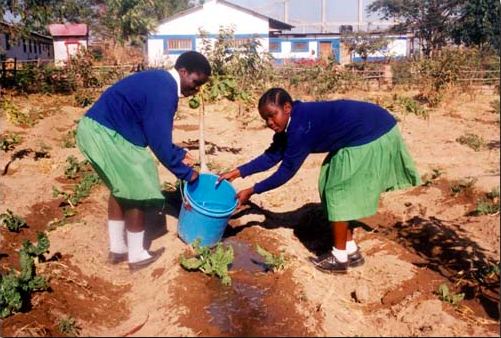
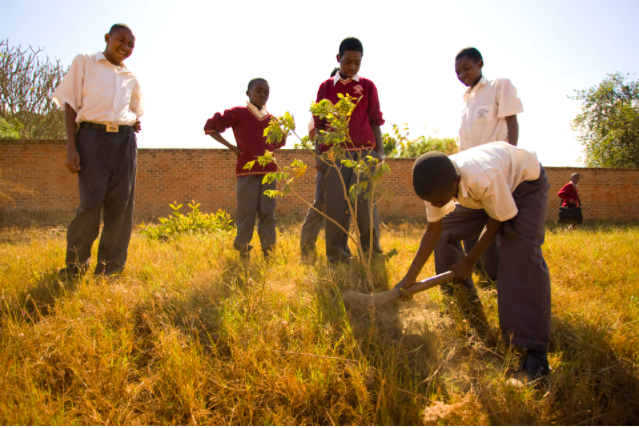
By 2010, as a result of nearly a decade and a half of systematic activity, populations in a number of countries in Africa developed greater collective capacity to address their social and economic needs, including production. At the center of this process was a system of distance education offered by Bahá’í training institutes and the strong spiritual foundations they laid in community after community. Complementing the efforts of institutes were several Baha’i-inspired organizations—supported by the Office of Social and Economic Development—that were gaining experience offering training to youth and adults, assisting them to contribute more systematically to advancing various aspects of the social and economic life of their communities.8Two programs were especially promising in their ability to empower youth and adults to contribute to the well-being of their communities: the Preparation for Social Action (PSA) program and a program for the promotion of community schools.
In hundreds of localities across the continent, this rise in capacity naturally made possible a wide variety of efforts in the area of social action, including in agriculture. For example, conversations among teachers and parents at community schools about the nutritional needs of children often led to the establishment of school gardens or farms. Consultations among groups of youth, learning about promoting the overall well-being of their communities, resulted in the creation of small-scale production projects. A pattern of study, consultation, action, and reflection—which was by now a hallmark of Baha’i activity worldwide—increasingly came to characterize agricultural efforts. Such developments helped create conditions for an increasingly systematic, community-led engagement in the area of agriculture.
Drawing Insights from the Experience of FUNDAEC
A number of Bahá’í-inspired organizations on the continent began to consider how to respond to the emerging capacity in the area of agriculture in a way that would be coherent with the process of community building and spiritual transformation already underway.
The insights generated by Fundación para la Aplicación y Enseñanza de las Ciencias (Foundation for the Application and Teaching of the Sciences, FUNDAEC) in Colombia were particularly valuable in this regard. Decades of experience with participatory agricultural research carried out with farmers of the Norte del Cauca region had enabled the organization to develop educational materials that would serve as both a record of this experience as well as tools for the generation, application, and dissemination of new knowledge specific to the context of given community. Among the educational materials, two units—“Planting Crops” and “Diversified High-Efficiency Plots”—were already included in the Preparation for Social Action (PSA) program being implemented in some countries in Africa as well as in the training offered to teachers of community schools.9The PSA program is centered on helping participants acquire capabilities in language, mathematics, science, and processes of community life including education, agriculture, health, and environmental conservation. The units are dedicated to building capacity to enhance food production on small farms, encouraging participants to engage in a process of action-research with their community.10For more information about FUNDAEC’s programs and its experience in agriculture, relevant publications can be found on its website, at www.fundaec.org
As part of the study, participants are assisted to reflect on the significance of agriculture for society and on the two sources of knowledge essential for the farmer: modern science and the experience of the farmers of the world. They explore the question of technological choice and its implications to the well-being of a community. They study the basics of plant biology, soil science, hydrology, entomology, plant pathology, and various options for water, pest, disease and weed management. They learn how to prepare compost and other organic fertilizers, how to establish and maintain a seed bank, and how to determine the nutritional content of a harvest. They reflect on questions about the value of hard work and collaboration, spiritual qualities needed in working in a group, and how the land is a living thing that needs to be cared for and protected. Above all, students engage in continuing conversations with farmers around them to learn from their experience and share new insights—an approach that encourages an ongoing community-level dialogue about production as well as agricultural science and technology.
The study of the two units among youth and adults in hundreds of localities across the continent gave rise to many initiatives and an increasingly rich conversation at the local level about various processes related to agricultural production. For those organizations that were being gradually drawn into the area of agriculture, building on the learning processes initiated in the units was a natural place to start. Through the encouragement of the Office of Social and Economic Development, a number of these agencies began to interact with one another more regularly in order to learn from each other’s experience and to begin thinking collectively about the challenges before them.
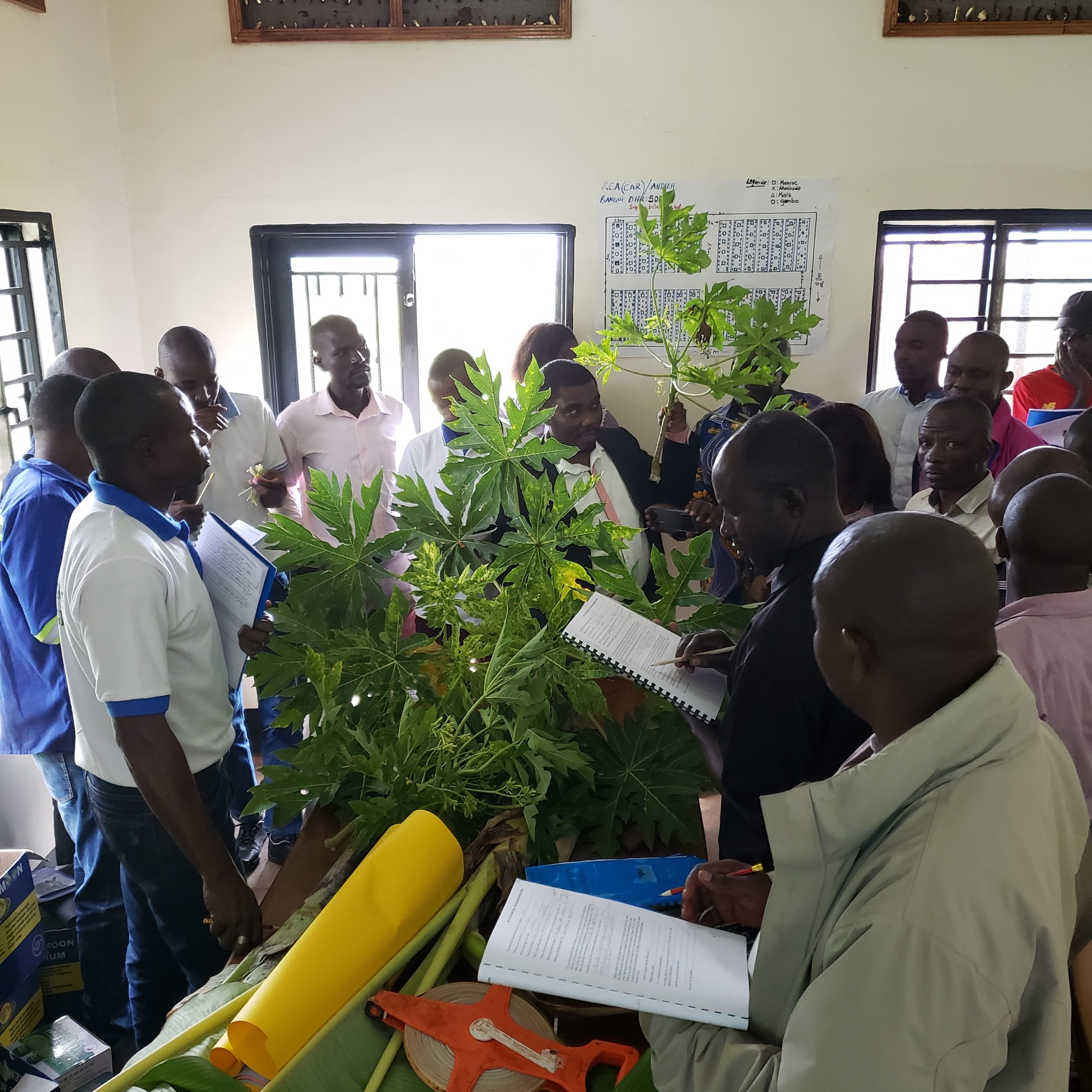
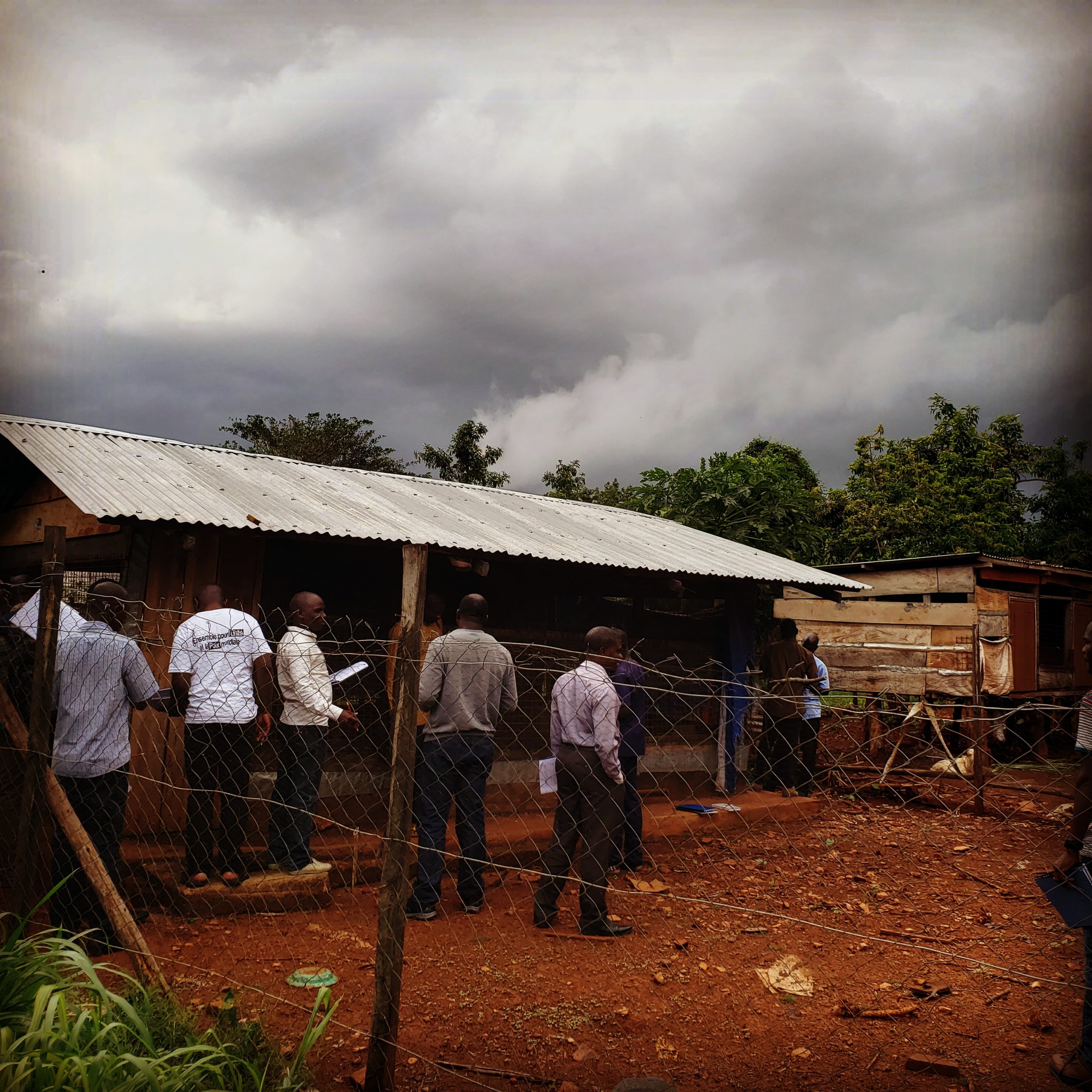
Building the Scientific and Technological Capacities of Farmers
This emerging network of organizations envisioned a long-term process of learning in the area of agriculture. The central aim, in addition to helping achieve food security, would be to build the scientific and technological capacities of farmers—vital to any long-lasting transformation in production processes and the village economy. In recollecting the evolution of agriculture in their respective countries, the organizations expressed their concerns about the sense of powerlessness felt by many farmers—especially those working on a small-scale—against the economic, social, and environmental factors that influenced their production and forced them to follow systems promoted by whichever organization would provide them with needed inputs at any given time. They further noted that local knowledge related to traditional systems of polyculture was being lost in an increasing number of communities. An effective program to empower the farmers in their respective regions would need to revive this knowledge and methods while also benefiting from the power of modern science.
Inspired by the words of Bahá’u’lláh that all human beings have been created “to carry forward an ever-advancing civilization”11Bahá’u’lláh, Gleanings from the Writings of Bahá’u’lláh, no. CIX, the organizations saw the farmers as partners in a process of generating, applying, and disseminating relevant agricultural knowledge, striving to establish approaches that would avoid the treatment of rural populations as mere consumers of technological packages developed outside their context. They were highly conscious of the fact that such a process would need to be rooted in participatory local action.
Learning About Elements of an Alternative System of Production
To meet its goal of building the scientific and technological capacities of farmers, the study of the units “Planting Crops” and “Diversified High-Efficiency Plots” by the participants needs to move beyond the theoretical; each participant or group has therefore been encouraged by the organizations to put various of its elements into practice through the establishment of a “diversified high-efficiency (DHE) plot”. This research plot is often between 500 and 2,000 square meters in size; where land is scarce, as in peri-urban settings, the participants establish backyard gardens using readily available containers.12The groups choose the crops they wish to grow on the basis of their study of factors relevant to crop association; they make decisions about irrigation and management of soil fertility, pests, and diseases; they determine how they will use the harvest; and, once harvesting is complete, they weigh the advantages of the system they have established with common systems of both monoculture and polyculture in their microregion. Factors include nutrient content, use of space, time and labor, and degree of risk. They set up a sequence of tasks and draw detailed designs and document the number of hours and the number of inputs spent in each step. They regularly write down their observations about the health of the plot with the aid of a diary. The establishment of raised beds and planting of seeds are carried out with great precision to ensure maximum efficiency of space and resources. While the different parts of the production process are each given due attention, the students are guided not to isolate any one factor but to view the plot as one ecosystem in which the different components are interdependent.
The production cycle—which lasts for a minimum of six months—enhances the capacities of the participants to observe, to plan and generate questions of learning, to make appropriate choices from among a number of alternatives after weighing costs and benefits, to create and use tools to collect data and document, to analyze the results of their observations and experiments and reach conclusions, to, in the final analysis, follow a dynamic process from its beginning to its end. Further, as those engaged in this action-research converse with farmers and involve them in their activities, such capacities, which are relevant not only to the field of agriculture but to all processes of community life, begin to permeate, gradually influencing the way farmers in a community approach their work.
Although the design of DHE plots vary from region to region, there are fundamental criteria for all.13Farzam Arbab, Gustavo Correa and Francia de Valcarcel, “FUNDAEC: Its Principles and Its Activities”. Published by CELATER: Cali, Colombia, 1988. For instance, such plots aim at addressing household food security. They need to be self-sufficient and sustainable, minimizing the use of costly inputs while at the same time providing stable and maximal yields. The plots must also conserve and enhance a farm’s natural resources, especially the soil. Other criteria include efficient use of space, even distribution of the time, resources, and energy required from the farming family over the course of the year, and regulation of income throughout the year to prevent periods of excess and deficit. And perhaps most critically, the systems and approaches need to consider the well-being of a whole community, thus encouraging collaboration rather than competition among families.
Glimpses from Across Africa
Already, thousands on the African continent in around 15 countries have studied at least one of FUNDAEC’s agriculture units, resulting in a large variety of initiatives to implement and promote the approaches contained in the units, as well as an expanding dialogue about questions related to agricultural technology and production. Most of these efforts are at a small-scale; some have grown in size and complexity. In a handful of countries, organizations have been building their capacity to follow a systematic research program.
Their impact, while still nascent, can already be discerned on a number of fronts. Many organizations have observed, for example, a gradual shift in attitudes among young people towards agriculture, with greater value being placed on this vital process of community life. Further, in a growing number of communities, the organizations are describing how members participating in their programs have been adopting a more thoughtful approach to considering the advantages and disadvantages of various technological proposals.
In Uganda, for instance, a group of youth that was approached by a development organization promoting maize monoculture systems requiring high use of chemical fertilizers and pesticides asked the organization’s representative numerous questions about the long term economic and environmental implications of the system; in the end, the group decided not to adopt it and shared with their tutor that they will no longer blindly follow the popular systems of the region. Another group reached out to village leaders and mobilized the community to construct a borehole on a piece of land donated by a group participant, providing water to sustain their experimental plot; group members also agreed to work on each other’s plots to ensure that all had time to study. The organization implementing the PSA program in the country, Kimanya-Ngeyo Foundation for Science and Education, established a large agricultural research farm, organizing training seminars and reflection spaces for tutors and participants to share their experiences with their plots. They further guided the program’s tutors to work with former and current participants as well as community members to establish similar research plots in each region where the program is being implemented.
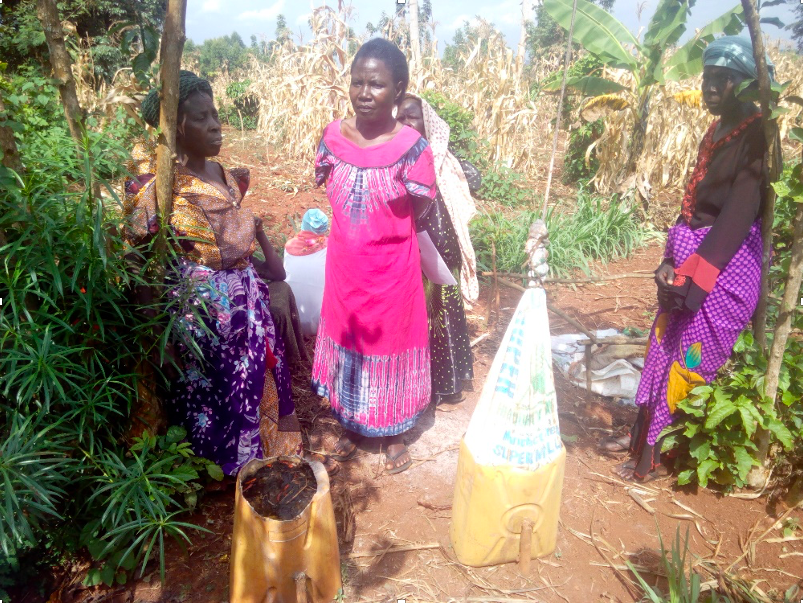
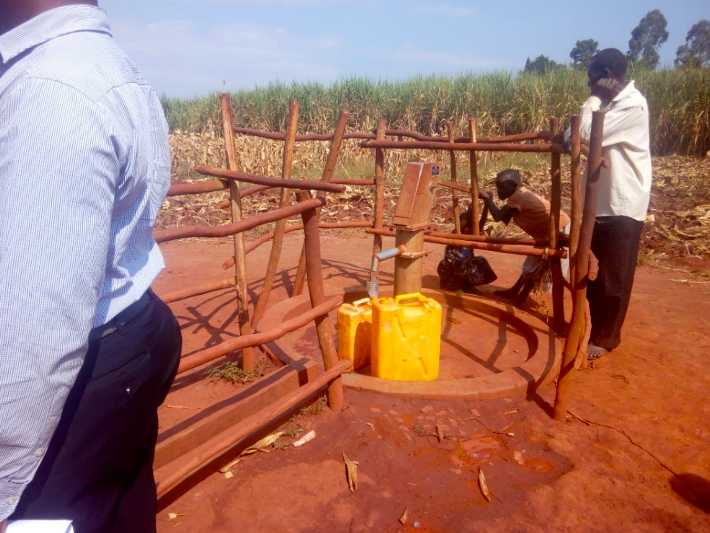
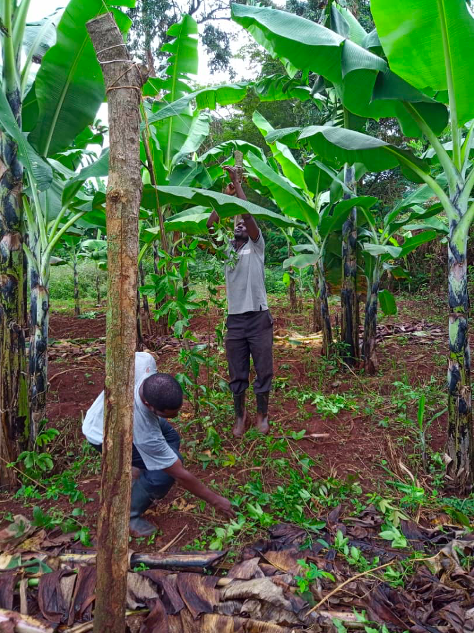
In Zambia, Inshindo Foundation carried out a campaign to promote backyard gardens in Kabwe, and 50 households adopted the practice. Follow-up efforts will examine how households’ production of food impacts their income and overall wellbeing. The agronomists of the Foundation are in a continuous dialogue with more than 500 farmers, many of whom have studied the agriculture units of the PSA program. The organization has recently launched a Center for Community Agriculture, where farmers from the community can study, consult, and experiment with different systems; the Center includes a local library, a seed bank, and a simple laboratory accessible to the community.

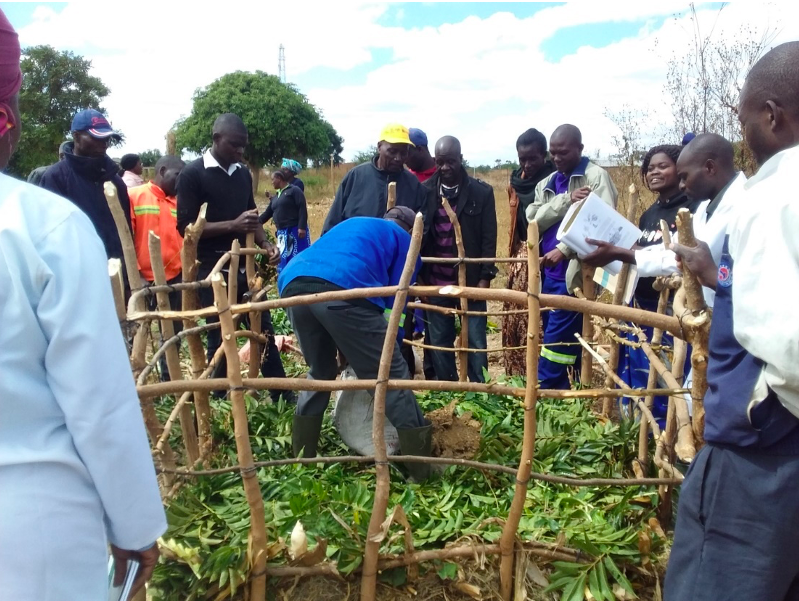
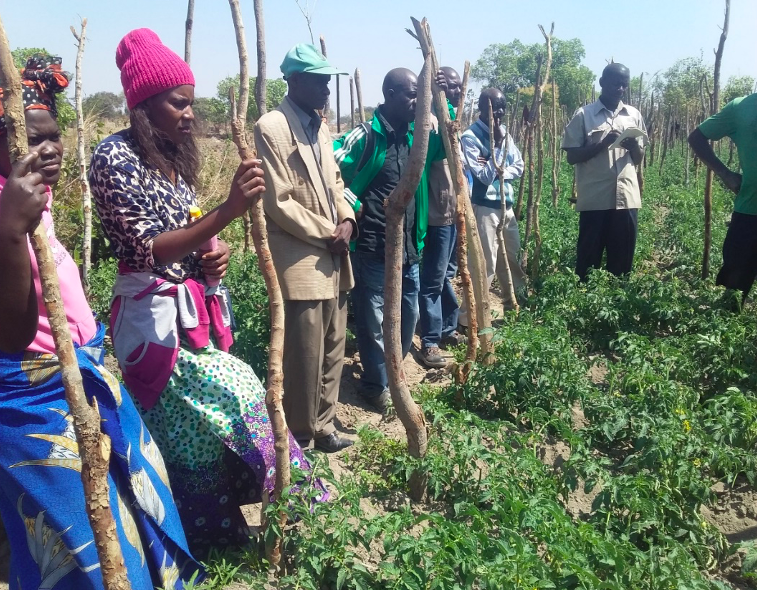
In Cameroon, several former and current participants of the PSA program offered by Emergence—a Baha’i-inspired agency in the country—established an association through which they undertake collective activities, including many in agriculture. In the eastern region, which has received a large number of refugees from Central African Republic, participants have entered into crop production and animal husbandry with the refugees to assist them in addressing their dietary and financial needs.
In the Central African Republic and Malawi, the plots established around Bahá’í-inspired community schools have centered on the nutritional needs of the children and have provided a laboratory for classrooms to study biological sciences. Further, many farms neighboring the schools have adopted the practices implemented on their learning plots.
While such stories abound on the African continent, given the complex and long-term nature of this sphere of endeavor, it would be premature to state that significant changes to production processes have resulted from these efforts. Nevertheless, an example from the south Kivu region of Democratic Republic of the Congo gives us a glimpse of a community that demonstrates the power of collective will to transform agricultural systems, grounded in spiritual principles and a systematic process of study, consultation, action, and reflection.
Reaching Thousands: Initial Insights from the Kivu Region, Democratic Republic of the Congo
Fondation Erfan-Connaissance, based in Bukavu, Democratic Republic of the Congo, has been offering its teacher-training program to promote the establishment of community schools in the Kivu region since 2007.
Following nine years of activity in the area of primary education, in 2016 the organization began to incorporate the two agriculture units of the PSA program in its teacher-training seminars, first offering them to its 31 facilitators and then to the 185 teachers whom they had been accompanying. The organization hoped that the study of the units would help in three areas: to build the scientific capacities of the teachers, to develop the capabilities needed to converse with families of their students about questions related to production and nutrition, and to improve their production systems and increase their income, especially in villages where teachers are also farmers. In schools with sufficient resources and capacity, DHE plots would be established to grow food for the students and serve as a learning space for both the students and the farming families in the community.
Soon after the first training seminar on the agriculture units, six schools established DHE plots, including one in the village of Canjavu in south Kivu—a number that has since multiplied. In the urban area of Goma in north Kivu, the teachers’ conversations with students and their families led to the establishment of around 80 backyard gardens. The influence of the training teachers received also led to other community agriculture initiatives, including a large seed bank project based in the Nshimbi village in south Kivu. Now, more than 1,000 individuals are engaged in some form with the DHE plots and backyard gardens and another 1,500 have been reached through seed distribution by the Nshimbi seed bank and dissemination of a number of technologies used in DHE plots among neighboring households, especially in Canjavu.
Backyard Gardens, Goma
The national primary curriculum of the Democratic Republic of the Congo contains basics of agricultural science. However, especially in urban areas where the value given to agriculture is increasingly lost and farming is viewed as the work of the uneducated, it was common for teachers of community schools to move quickly past lessons related to the topic. Following the initial training on the two PSA agriculture units in 2016, however, Fondation Erfan-Connaissance noticed a rise in appreciation for agriculture among the teachers in Goma and an increase in their engagement with students about the subject. Although it was difficult for most schools there to establish plots—Goma is a volcanic area and the size of land available to schools and households is very small—a few schools with sufficient resources were able to begin cultivating crops, from which the students learned about the process of plant growth.
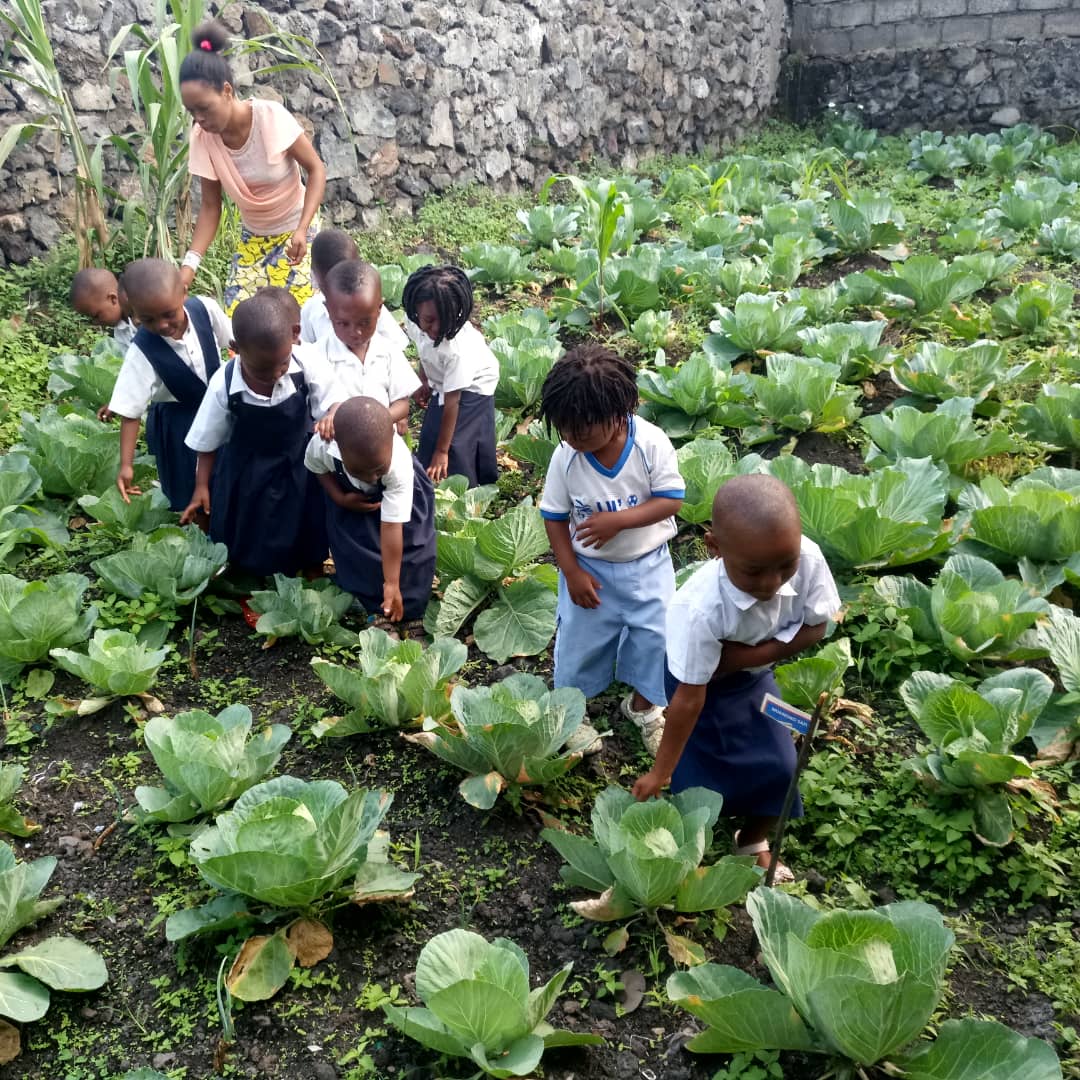
As a result of conversations about production in and outside the classroom, a number of students approached their parents to ask whether they could plant some crops in their backyards. This effort was also supported by the teachers and program coordinators during their visits to the households. In most cases, the parents helped with obtaining the seeds, and the students began to take care of the crops. Within a period of around one year, some 80 backyard gardens had been established. The teachers regularly visited their students’ gardens and witnessed not only the rise in their capacity to manage their garden but also greater evidence of qualities such as patience, determination, and generosity.
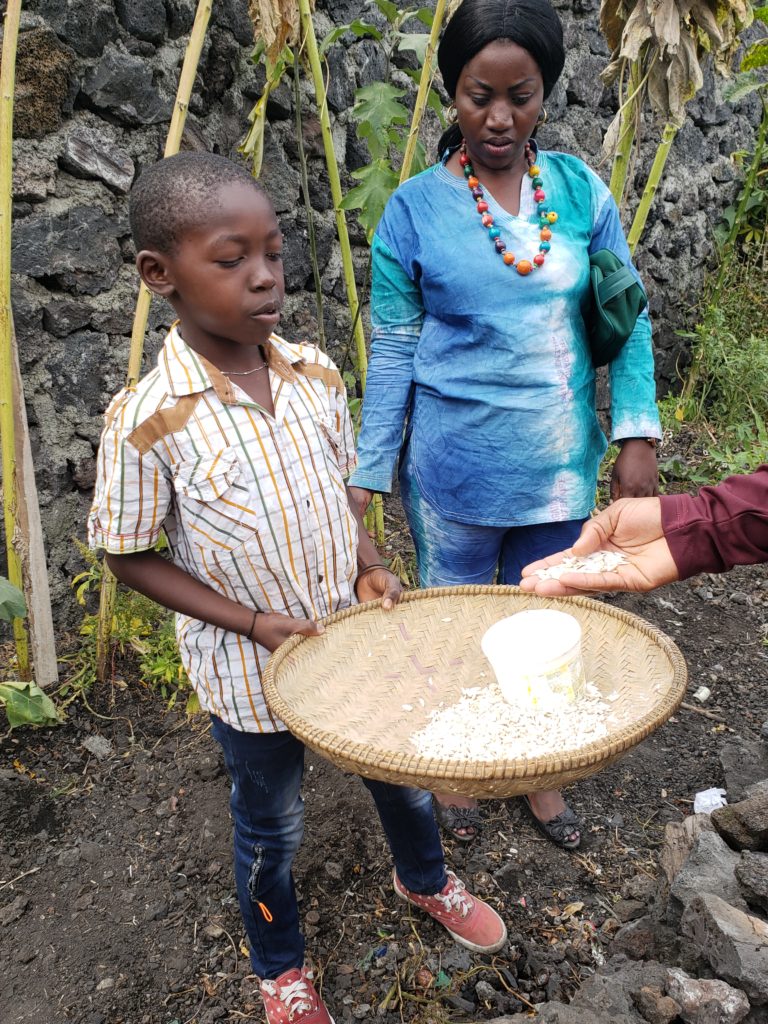
Gradually, the coordinators of the teacher-training program in Goma began to observe changes in the nature of interactions between families in neighborhoods with backyard gardens. Households began to exchange planting materials and share experience and advice. In one neighborhood, six families began to collaborate very closely in their production activities, growing medicinal plants as well as food crops.
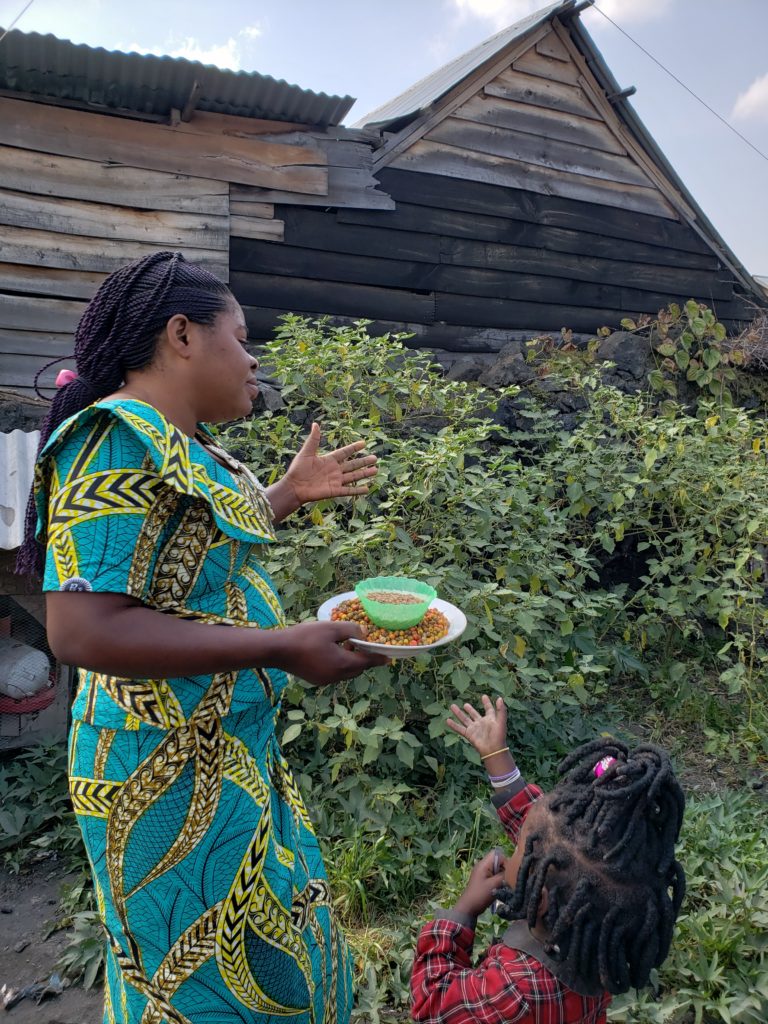
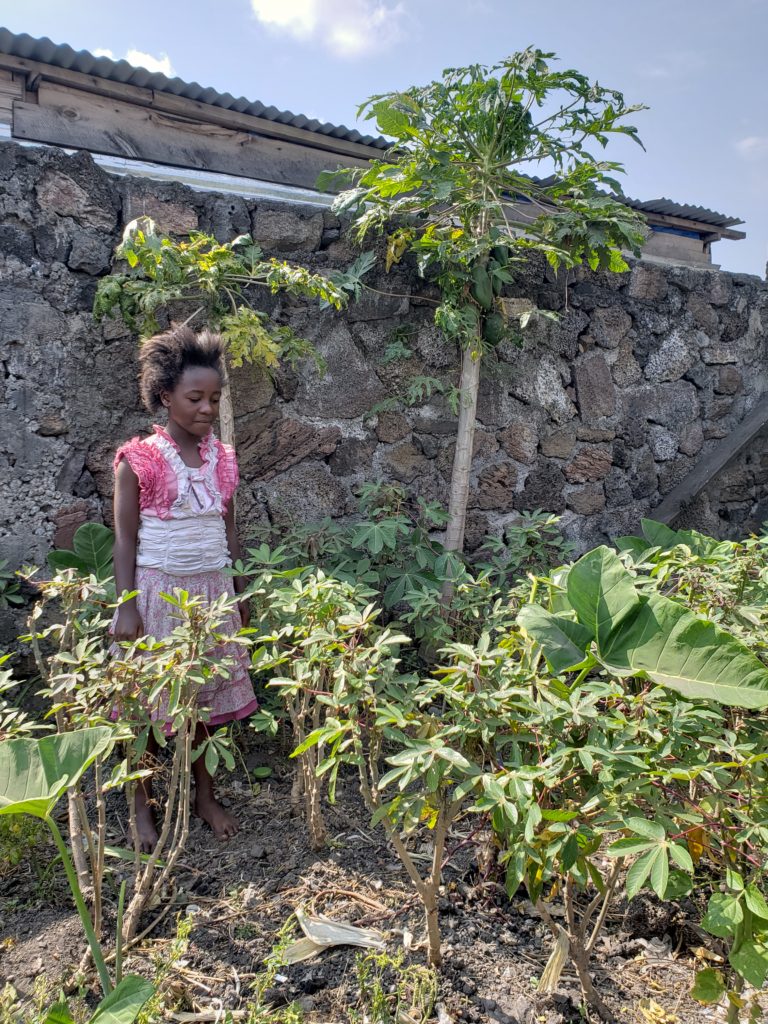
Further, as the work on gardens continued, the families were able to supplement their income by selling their produce in the local market. In response to the growing interest in urban farming, and to encourage more to engage in the process, two of the Bahá’í-inspired community schools established seed banks, and one began to provide seedlings to five other community schools as well as a number of teachers and community members. Agriculture became an essential topic of conversation during parent-teacher meetings at schools, and reflection meetings focusing specifically on production emerged with an average participation of 120 individuals.
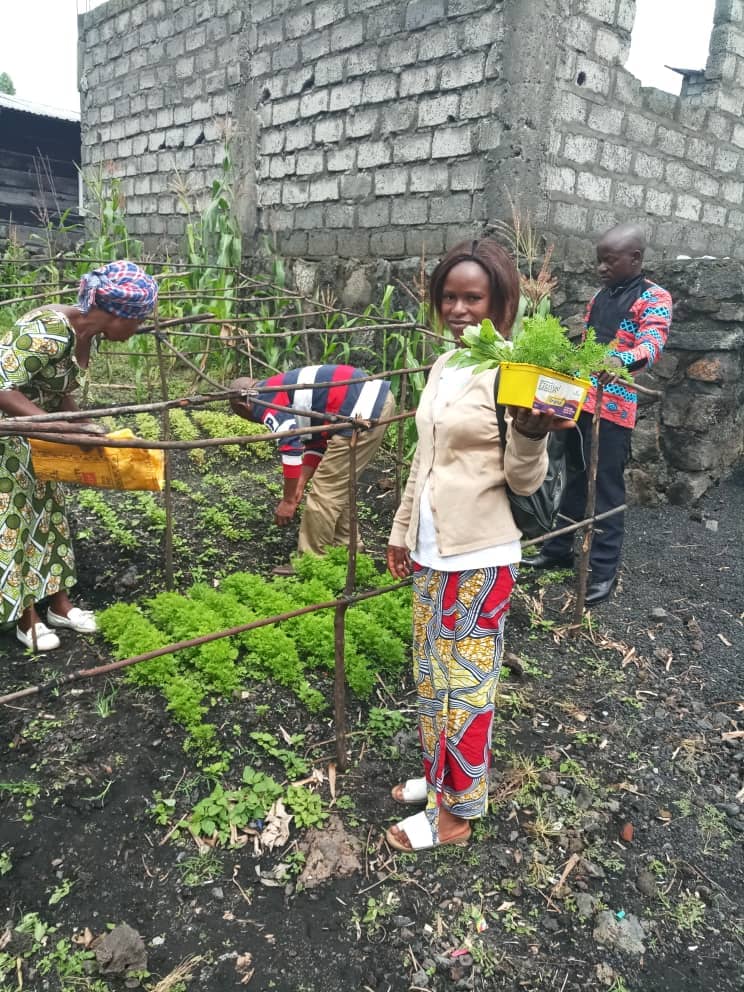
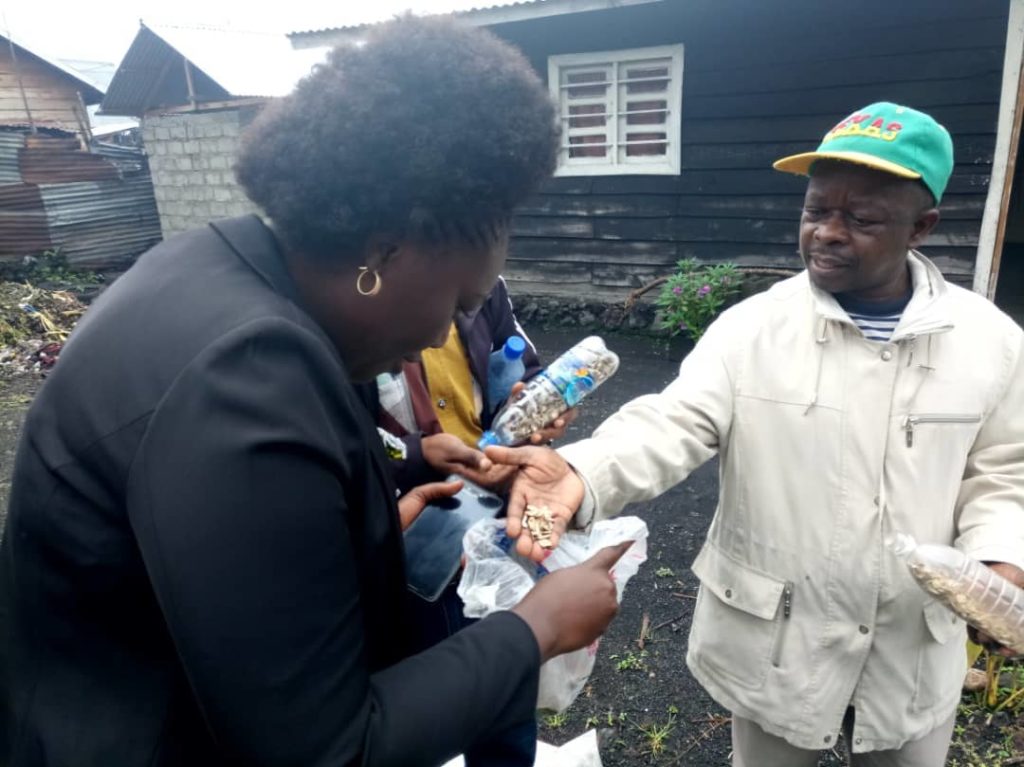
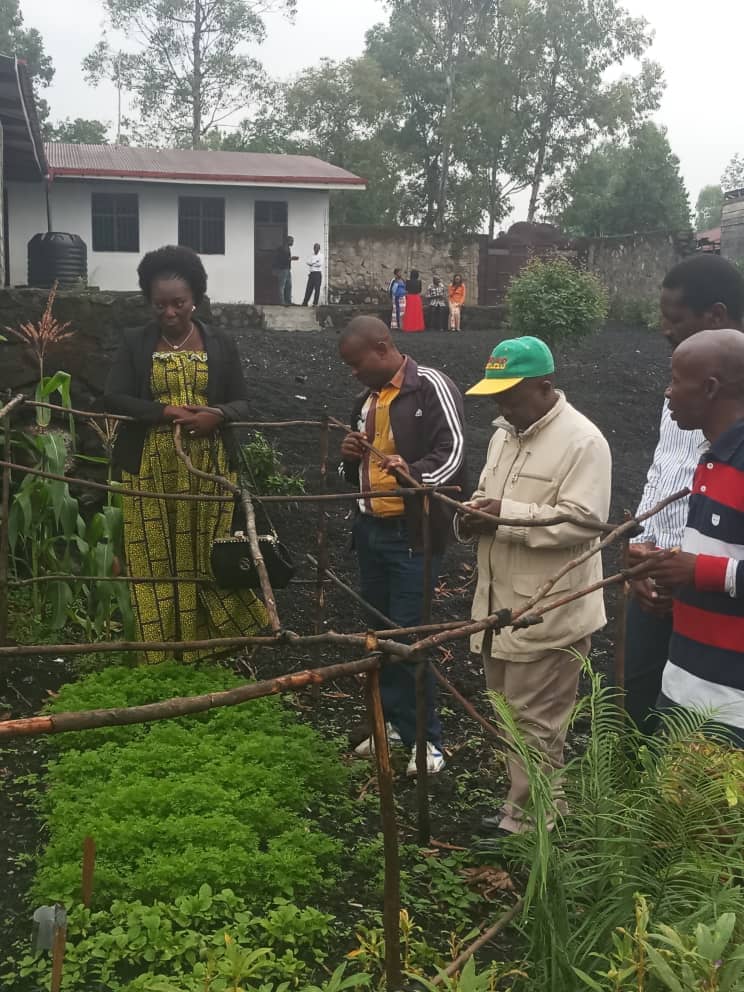
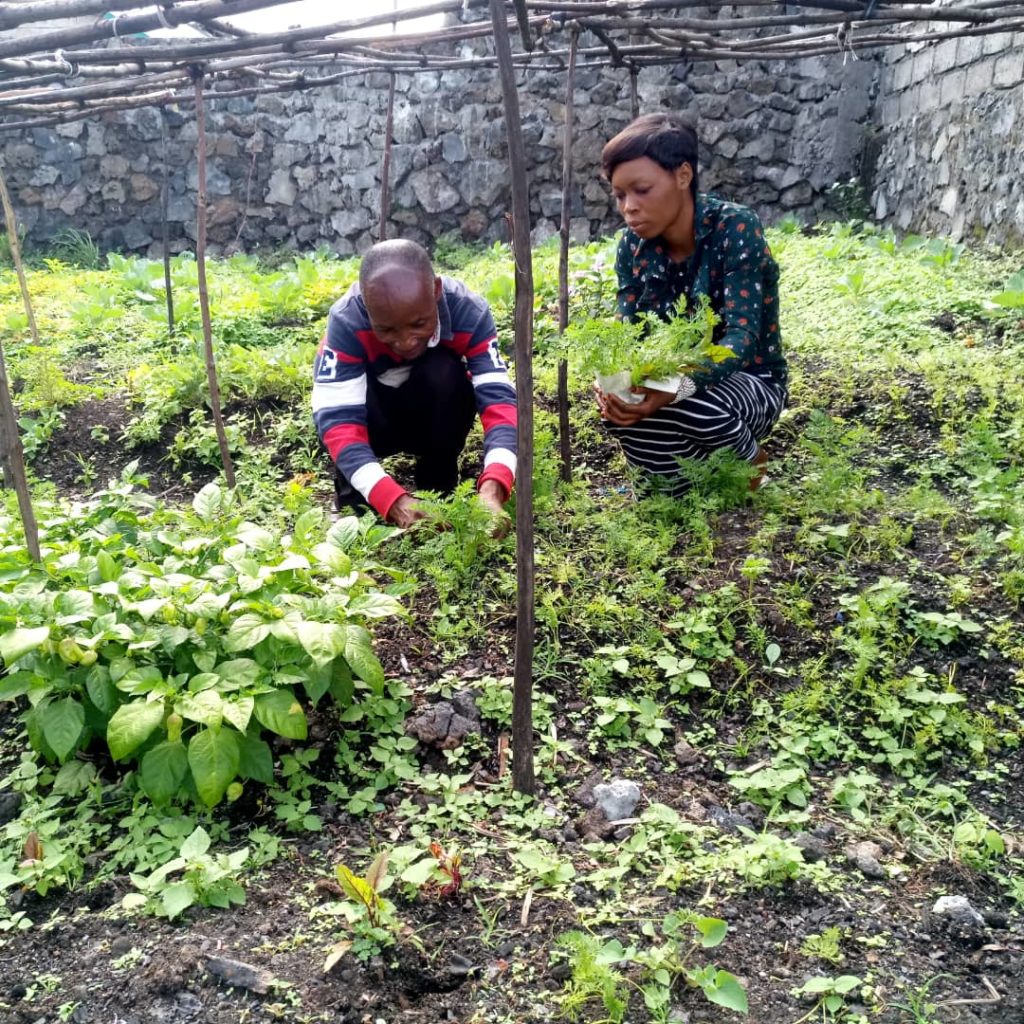
Community Seed Bank, Nshimbi Village, South Kivu
The village of Nshimbi is a center of intense Bahá’í community building activity; there are approximately 250 residents who participate regularly in devotional meetings, 280 children who attend Bahá’í children’s classes, around 140 participants in the junior youth spiritual empowerment program, and about 90 engaged in study circles. To respond to the academic needs of the children, a Bahá’í-inspired community school was established in the village in 2016.
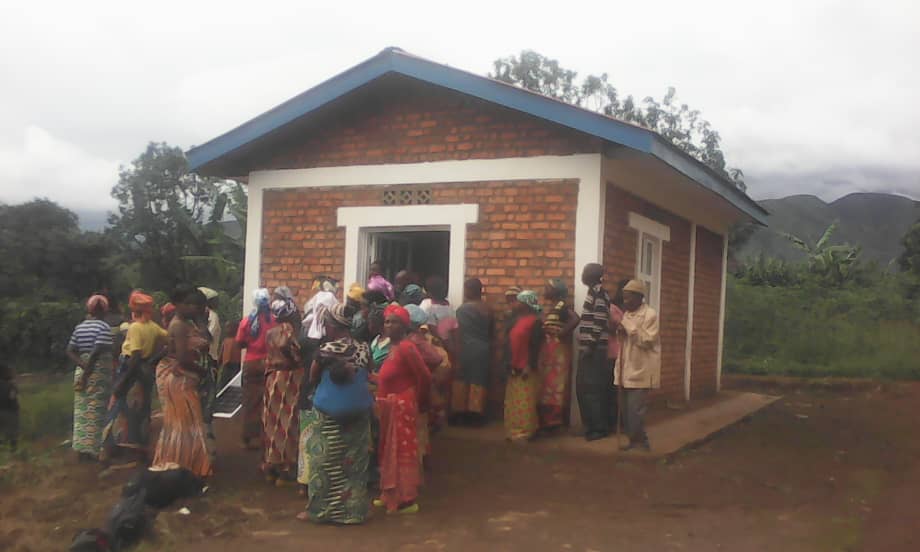
After receiving training on the two PSA units on agriculture, one of the teachers, accompanied by the agronomist of the Foundation, started a conversation with the village chief and community members about the need to diversify production systems and establish a local seed bank. The chief convened a meeting with the participation of over 500 individuals, and as a result of the consultation, the community decided to allocate two plots with a total area of approximately 12,000 square meters for the production of seeds and cuttings of a large variety of species. Further, each family was encouraged to establish a vegetable garden to diversify locally available products.
As these efforts gained momentum, the community approached a development organization promoting seed banks to help in the construction of a small building for the bank; the community contributed bricks, sand, and labor, while the organization donated cement and metal sheets. A structure of 35 square meters was thus constructed within a few weeks on a piece of land donated by the chief. In addition, the community put together an administrative arrangement to oversee the bank’s operations.
Among the 25 families that initially made up the bank’s membership, three committees were formed—a management committee to organize meetings and handle the bank’s records, a monitoring committee to distribute the seeds and help members of the community with aspects of cultivation so that they could meet their commitments to the bank, and an advisory committee, of which the village chief would be a member, to protect the initiative from moving in undesirable directions. Further, a number of solidarity groups emerged around the bank focusing on the sale of the agricultural products, on animal husbandry, and on adult literacy. The families would obtain a certain amount of seeds as a loan and would return it with an interest rate that differed from crop to crop; for maize, for instance, the farmer was to return 1.5 kilograms of seed for every kilogram borrowed. Within one year, the number of families who were members of this committee increased from 25 to 200, joining from eight neighboring communities.
In a recent reflection meeting, a mother commented that the seed bank was addressing the problem of malnutrition in the village, as families had been planting monoculture systems before its establishment, which limited the number of crops available for household consumption. It was also observed that the participation of women in community consultations has increased. Further, 60 of the 200 families have entered into animal husbandry from the profit they have made by diversifying their products.
Multiplication of DHE plots and secondary production, Canjavu village, South Kivu
The village of Canjavu is located around 45 minutes west of Bukavu, the capital of the South Kivu province. It has a population of approximately 3,900 divided into around 500 households. As of April 2020, a large percentage of the population in the village was engaged in more than 600 community-building activities inspired by the teachings of the Bahá’í Faith, including 468 devotional meetings, 40 Bahá’í children’s classes, 50 junior youth groups and 42 study circles. These activities assist the community members to develop their spiritual and intellectual capacities and provide social spaces for meaningful conversations. This has, in turn, led to a systematic process of study, consultation, action, and reflection over ways in which they can advance the various processes of community life, including education, health and agriculture.
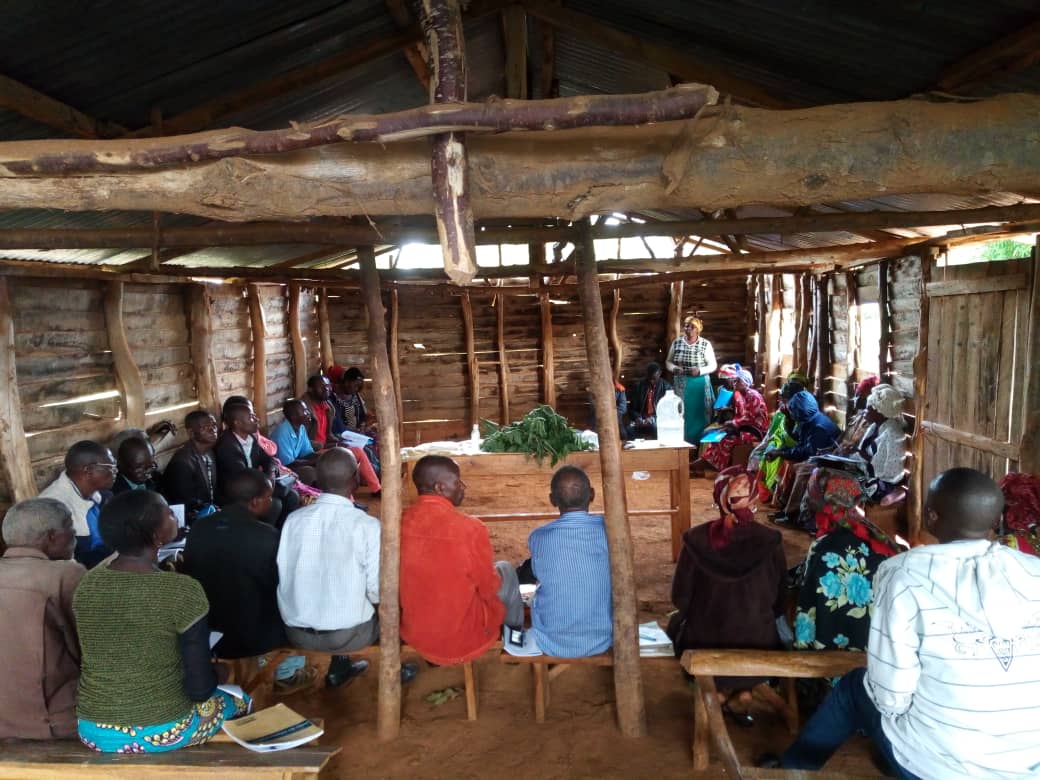
The Bahá’í-inspired community school serving the village, Ecole Communautaire Muzusangabo, was established in 2011; currently 105 students attend kindergarten through grade 6. During 2016 and 2017, the school’s teachers as well as 45 farmers from the village and three nearby localities participated in training offered by Fondation Erfan-Connaissance. The training led to the establishment of a DHE plot connected to the school to meet the nutritional needs of the students and serve as a source of income for the school, as well as DHE systems on the farms of those participating in the study. In 2019, the participants decided to each accompany three households that had shown interest in establishing diverse systems on their own plots, leading to the establishment of around 100 DHE plots in the village. As a result, during the Covid-19 pandemic, one village resident stated:
During this health crisis, we are not afraid of running out of food because while we are planting, we are also enjoying the harvest of our previous cultivation. In addition, with the closure of schools, our junior youth… prepare their small plots to help their families. They cultivate amaranth whose leaves are excellent for health.14https://www.bahairdc.org/index.php?option=com_content&view=article&id=154:la-crise-sanitaire-une-source-d-unite-spirituelle-pour-le-quartier-cpa-lubobo-2&catid=137&Itemid=571
Technical assistance from a local Bahá’í-inspired organization allowed the community to expand the scope of its production activities. In addition to food crops addressing dietary needs, they began to cultivate beetroots as a cash crop in order to produce and sell juice. The funds generated from the sale enabled them to purchase school supplies and to address other community needs. They obtained blenders to simplify the juice-making process and a basic milling machine to grind their own flour, producing donuts that have become popular in neighboring towns and villages.
Beyond the increased capacity of the community to engage in collective income-generating projects, a notable outcome of the action-research process has been a rise in the farmers’ scientific and technological capacities.15They have experimented with the effect of Tithonia on production, comparing untreated and treated sections of land, concluding that fertilizers and pesticides made from the plant have notably increased yields. They questioned assumptions regarding which crops grew well in the region and experimented with planting a number of them, including onions that provided a good harvest. They showed determination when the school plot did not produce well one year, questioning the causes and identifying the plot’s distance from the school to be a significant factor preventing regular monitoring; they have since relocated the research plot, which resulted in increased production. The spiritual qualities and the scientific capacities developed by the group, and the resulting rise in their production, have attracted the interest of other households in the village. While DHE systems are running in 100 households, almost all 500 households participate in the village reflection meetings on agriculture, encouraged by the chief.
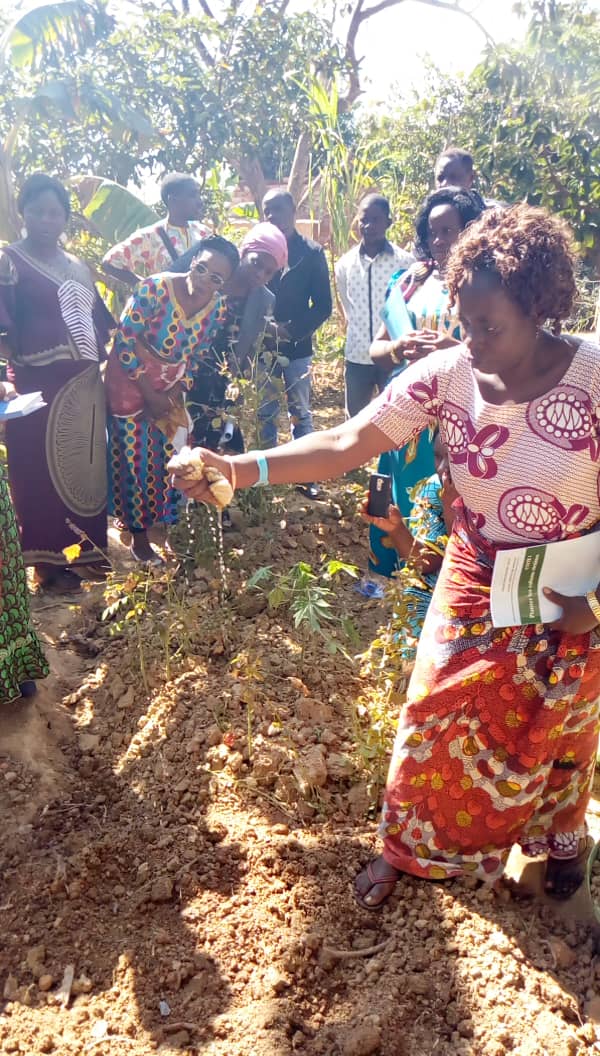
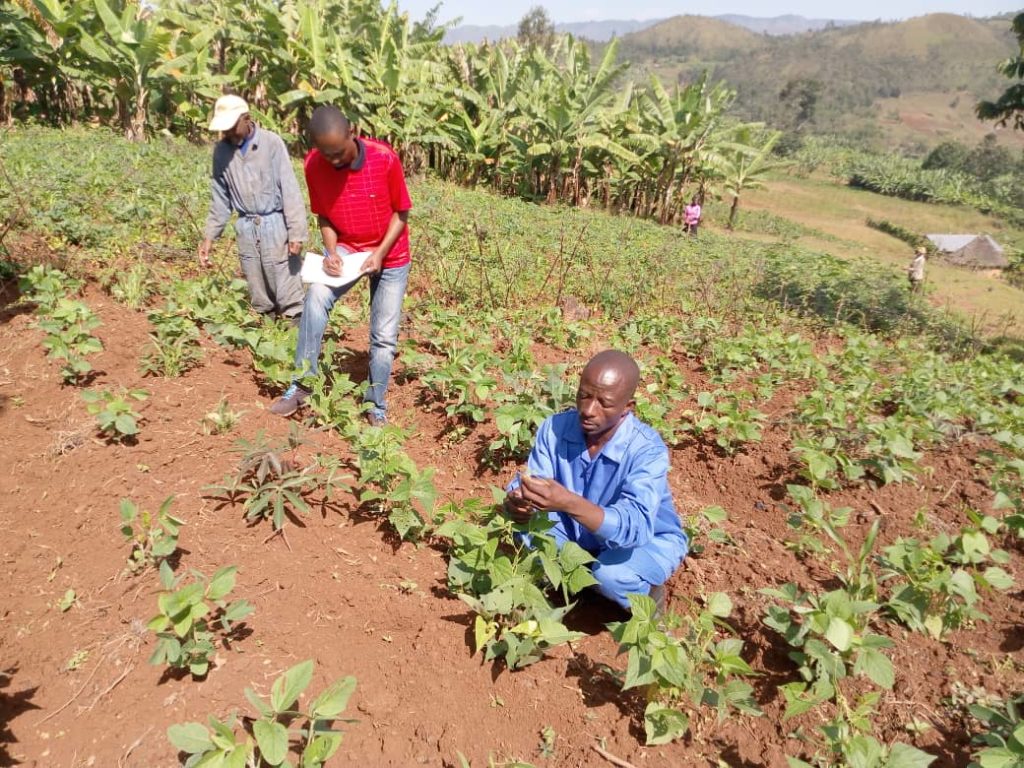
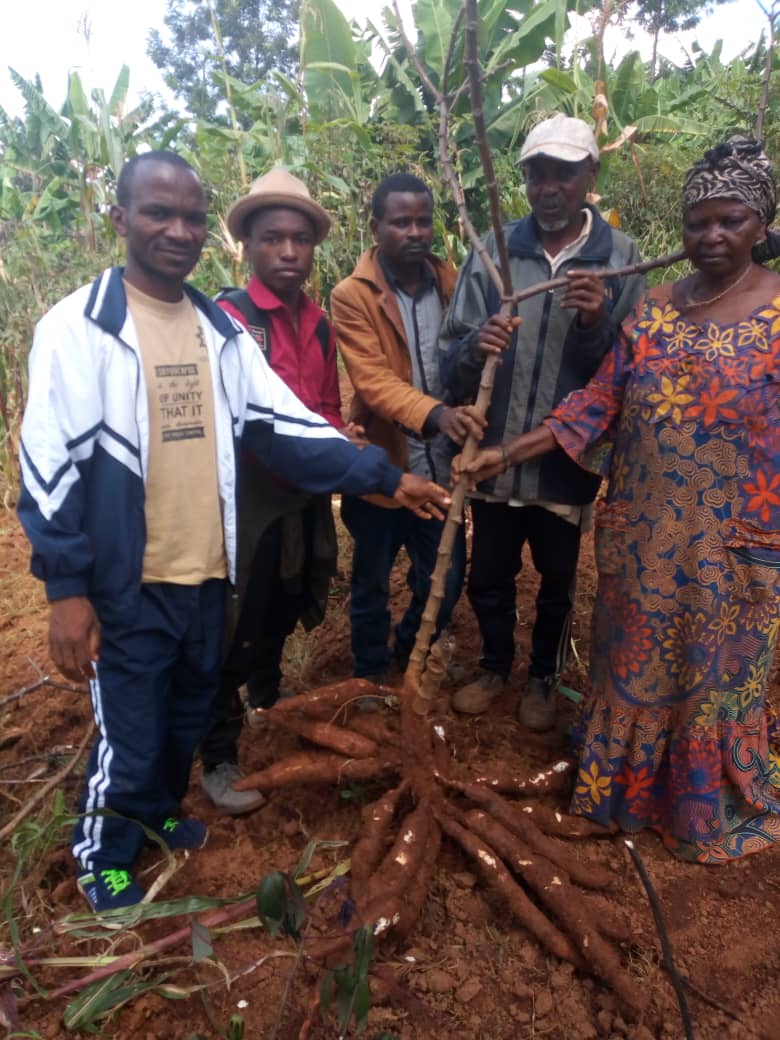
The story of Canjavu has been spreading within the region. They have received students from nearby universities who wish to learn about their systems, and a member of the community actively engaged in the plot was asked by the representative of a regional agricultural cooperative to visit different communities with her and share the group’s experience and learning. The director of the Bahá’í-inspired school in the village has commented:
The spirit of unity in the village of Canjavu attracts neighboring villages which also want to learn. People see how present evils are overwhelming humanity. They feel that it is time to join any human enterprise that seeks to act in the Light of Unity!16 https://www.bahairdc.org/index.php?option=com_content&view=article&id=154:la-crise-sanitaire-une-source-d-unite-spirituelle-pour-le-quartier-cpa-lubobo-2&catid=137&Itemid=571
Future Prospects
At the time of writing this article, humanity is experiencing a worldwide pandemic that has not only already caused the loss of hundreds of thousands of souls but has put the livelihoods of millions more into great jeopardy. Africa has not been immune, and the prospect of famines continues to threaten the continent as it does the rest of the world. Restrictions on movement that have reduced the exchange of products between regions and countries have made it ever-more urgent for each and every community to think deeply about the question of food, and communities are questioning the path that has led them towards dependency.
“Be anxiously concerned with the needs of the age ye live in,” are the words of Bahá’u’lláh, “and center your deliberations on its exigencies and requirements”17Bahá’u’lláh, Gleanings from the Writings of Bahá’u’lláh, no. CVI. “For all beings are linked together like a chain;” says Abdu’l-Bahá, “and mutual aid, assistance, and interaction are among their intrinsic properties and are the cause of their formation, development, and growth.”18Abdu’l-Bahá, Some Answered Questions, no. 46 Can neighborhoods and villages be assisted to consult prayerfully together to determine ways in which they can produce and market their staple foods in collaboration with each other? What would it take for each household in cities and villages to grow food with whatever resources are available to them? Can current systems focusing entirely on cash crops for export be transformed into systems that would also meet the nutritional needs of thousands of a country’s residents? Can the youth of each community, many of whom have thus far chosen to move away from agriculture and rural areas, seeking the promise of a better life in overcrowded urban settings—a promise that very often leads to disappointment—be encouraged and assisted to channel their energies and focus towards advancing agriculture? How can efforts build on the spirit of service that is characterizing an increasing number of communities that have been in touch with the Creative Word? These are the types of questions that are currently being explored by Bahá’í-inspired organizations engaged in agriculture in Africa as they recall the words of Abdu’l-Bahá that the “fundamental basis of the community is agriculture… All must be producers”.
